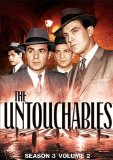I was entirely too young to remember even the syndicated run that my mother was watching in the late 1960’s. Under more normal circumstances that would not matter as I could introduce myself to this world with the DVD release. That was before 1987, and the release of Brian De Palma’s classic film. Honestly, I simply can’t watch these episodes without thinking of that movie. For an entire generation that film has defined these characters and that time. It’s unfortunate, really, because this 1960 series had a lot going for it, particularly when you look at what else was on television at that time. Never before had such brutal violence in such a starkly real world graced the black and white sets of America. When I read articles about the controversy surrounding these depictions, I am forced to smile a little. By today’s standards these shows are quite tame. Still, the flurry of protests the show spawned were quite real. Italians were also vocal in their belief that the show went too far in portraying nearly every bad guy as being of Italian descent. I have to admit some of these accents make Father Sarducci sound good. Complaints went as far as the US Attorney General. My, have things changed. I am also of Italian heritage and gladly sit down to an hour of Tony Soprano, eating it up about as fast as a bowl of tortellini and gravy. While there are still those of us who feel racially exploited, most of us embrace the mob mythology of The Godfather and Goodfellas. We can accept the difference between reality and fantasy. And so I watch these episodes as if I were some remote viewer, not only from a different time but a different place.
The Untouchables took on a perhaps too convincing appearance of reality. Remember that the audience was made up of folks who grew up getting their news from newsreels at the local theater. It was a stroke of genius to have real life news reporter Walter Winchell narrate the series. Everything from that narration to the gritty dark photography carried a documentary style feel to every minute of the action. You can only imagine why too many Americans thought it was too violent. The show wasn’t too violent. It looked and felt too realistic. Robert Stack literally becomes the persona of Elliot Ness. The show was also based on a book that was co-written by Ness himself but was highly fictionalized by the time it reached millions of homes each week. In truth Ness’s team didn’t exist long after bringing down Capone for tax evasion. In the series the team becomes a strike force of sorts against an entire mug book of criminals real and imagined.
Frank Nitti (Gordon) was the main bad guy for the team, but there were many gangsters featured both in and out of the Capone regime. The shows did not follow a linear chronology. One week it’s 1932. Next week it’s 1934. Then it’s back to 1931. The series didn’t stay on the bootleg business either. There were episodes like The White Slavers which took place after Prohibition and dealt with prostitution. Gambling was a huge industry in this world, as was simple murder for hire, mostly potential witnesses. Each week Ness and his team of Untouchables, named so because they could not be bribed, would take on an aspect of Chicago’s underworld, usually staying only one step ahead of the gangsters. There’s plenty of machine gun fire and even car chases in vintage automobiles. And every moment of it was performed with careful attention to detail.
The dialog sounds like it came out of a dime detective novel, but it was likely how most people expected them to sound, so it wouldn’t have taken them out of the experience at all. Today it all looks incredibly dated. But it’s still worth a look.
This collection features some impressive guest stars that include: Leonard Nimoy, Robert Loggia, Lee Marvin, Victor Jory, Patricia Neal, Vic Morrow, Cloris Leachman, Martin Balsam, Simon Oakland, Steven Hill, Pat Hingle, Booth Coleman, Warren Oates, and Claude Akins.
Video
Each episode of The Untouchables is presented in its original full frame broadcast format. The show is also in black and white. There are plenty of specks and print artifacts here. There’s also entirely too much compression artifact to give this presentation anything but a below average rating. The black levels are actually pretty strong, but almost nothing else is. This is nearly a 50 year old series, so our expectations shouldn’t be very high to begin with. I can forgive all the print defects, but the compression is unforgiveable. The bit rate clocks in at an average 3 mbps which is unimpressive. Look at it this way, if you must. The weak image only adds to the historical feel you get watching something like this.
Audio
The Dolby Digital Mono track is actually in better shape than the video. I’m impressed with the clarity throughout. Don’t get me wrong, it sounds like it’s old, just not 50 years old. Dialog is clear, and the gunfire pings and blams its way to your ears unfettered by distortion.
Special Features
Nothing
Final Thoughts
Of special note here is the episode Pressure. It deals with the end of Prohibition and the beginning of the narcotics rackets. It’s an interesting aside for this particular half season. With only one season to go, do you think Paramount might relent and just spill it in a single release? “I wouldn’t wanna give odds.”




